Burt A. The Evolution of the British Empire and Commonwealth From the American Revolution
Подождите немного. Документ загружается.

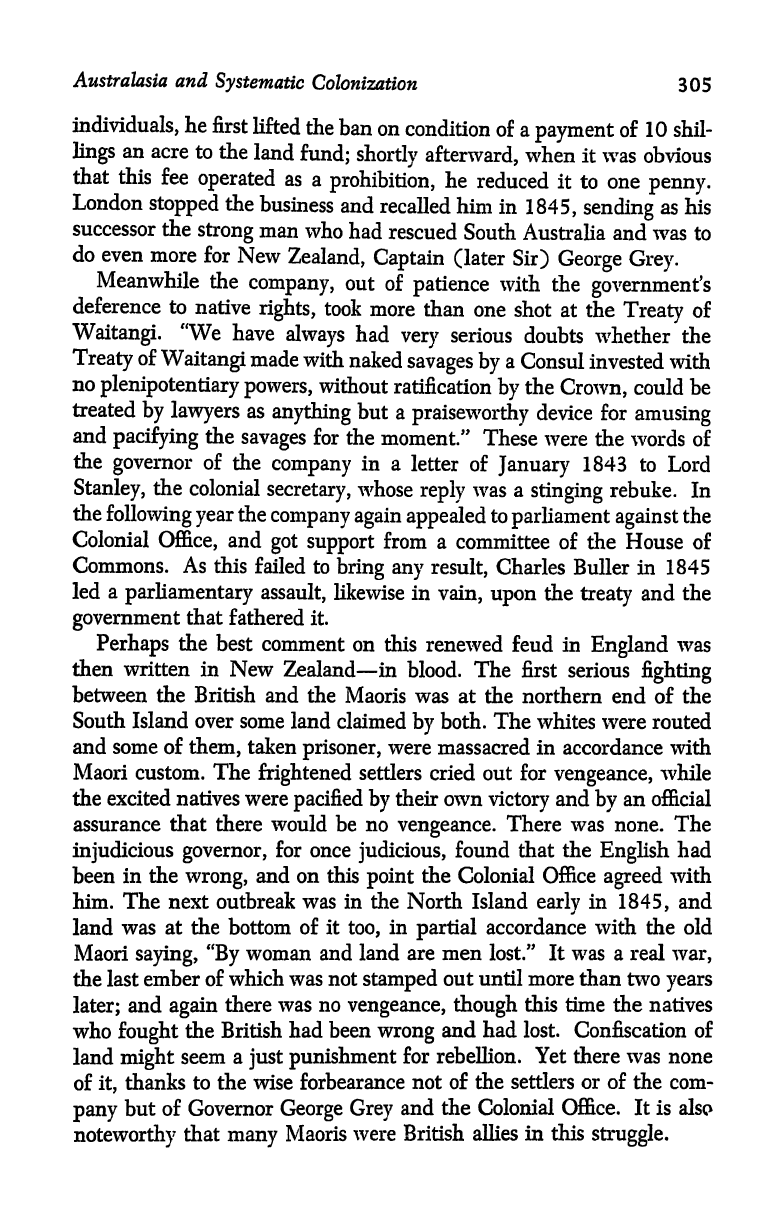
Australasia and
Systematic
Colonization
305
individuals,
he
first
lifted
the
ban
on
condition
of
a
payment
of
10 shil-
lings
an
acre
to
the
land
fund;
shortly
afterward,
when
it was obvious
that this
fee
operated
as
a
prohibition,
he
reduced
it to
one
penny.
London
stopped
the
business
and
recalled him in
1845,
sending
as his
successor
the
strong
man
who
had
rescued
South
Australia and
was
to
do
even
more for
New
Zealand,
Captain
(later
Sir)
George
Grey.
Meanwhile
the
company,
out
of
patience
with
the
government's
deference
to
native
rights,
took
more
than
one
shot at the
Treaty
of
Waitangi.
"We
have
always
had
very
serious
doubts
whether
the
Treaty
of
Waitangi
made
with
naked
savages
by
a
Consul invested
with
no
plenipotentiary
powers,
without
ratification
by
the
Crown,
could
be
treated
by
lawyers
as
anything
but
a
praiseworthy
device for
amusing
and
pacifying
the
savages
for
the
moment."
These
were the
words of
the
governor
of
the
company
in a
letter
of
January
1843
to
Lord
Stanley,
the
colonial
secretary,
whose
reply
was
a
stinging
rebuke. In
the
following
year
the
company
again appealed
to
parliament
against
the
Colonial
Office,
and
got support
from
a
committee
of the House of
Commons. As
this
failed to
bring any
result,
Charles Buller in 1845
led
a
parliamentary
assault,
likewise
in
vain,
upon
the
treaty
and the
government
that
fathered it.
Perhaps
the
best
comment on this
renewed
feud
in
England
was
then
written
in
New
Zealand in
blood. The first
serious
fighting
between the British
and the
Maoris was at
the northern end
of
the
South Island
over
some
land
claimed
by
both.
The
whites were routed
and
some
of
them,
taken
prisoner,
were
massacred
in
accordance
with
Maori custom.
The
frightened
settlers
cried out for
vengeance,
while
the excited
natives
were
pacified
by
their
own
victory
and
by
an official
assurance
that
there would be
no
vengeance.
There
was none. The
injudicious governor,
for
once
judicious,
found that
the
English
had
been
in
the
wrong,
and on this
point
the
Colonial Office
agreed
with
him.
The next outbreak was in the North
Island
early
in
1845,
and
land
was
at
the bottom
of it
too,
in
partial
accordance
with the old
Maori
saying,
"By
woman and land
are men
lost." It was a real
war,
the
last
ember of
which was not
stamped
out
until
more than two
years
later;
and
again
there
was no
vengeance,
though
this time the natives
who
fought
the British
had been
wrong
and
had lost. Confiscation of
land
might
seem
a
just
punishment
for rebellion.
Yet there
was none
of
it,
thanks
to the wise forbearance
not of the settlers
or of
the com-
pany
but
of Governor
George
Grey
and the
Colonial
Office. It is
also
noteworthy
that
many
Maoris
were British allies
in this
struggle.
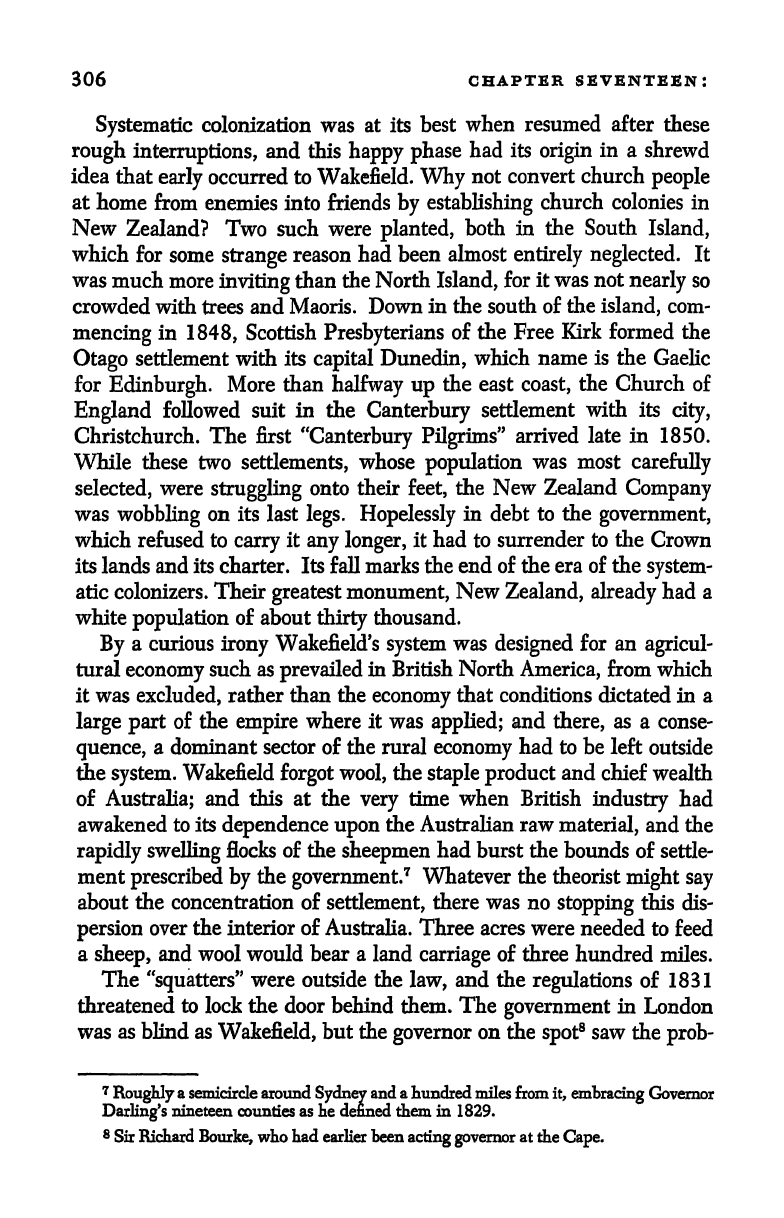
306
CHAPTER
SEVENTEEN:
Systematic
colonization
was at its
best
when
resumed after
these
rough
interruptions,
and
this
happy
phase
had its
origin
in
a
shrewd
idea
that
early
occurred
to
Wakefield.
Why
not
convert church
people
at
home
from enemies into friends
by
establishing
church colonies
in
New
Zealand?
Two such
were
planted,
both
in
the
South
Island,
which
for
some
strange
reason had been
almost
entirely
neglected.
It
was
much
more
inviting
than
the
North
Island,
for it
was
not
nearly
so
crowded with
trees
and
Maoris.
Down
in
the
south
of
the
island,
com-
mencing
in
1848,
Scottish
Presbyterians
of
the Free
Kirk
formed
the
Otago
settlement with its
capital
Dunedin,
which
name
is the
Gaelic
for
Edinburgh.
More
than
halfway
up
the
east
coast,
the Church
of
England
followed
suit
in
the
Canterbury
settlement
with
its
city,
Christchurch. The first
"Canterbury
Pilgrims"
arrived
late in 1850.
While
these two
settlements,
whose
population
was
most
carefully
selected,
were
struggling
onto their
feet,
the
New
Zealand
Company
was
wobbling
on
its last
legs.
Hopelessly
in
debt
to
the
government,
which refused to
carry
it
any
longer,
it
had
to
surrender
to die
Crown
its
lands
and its charter. Its fall marks the
end of
the
era of the
system-
atic colonizers.
Their
greatest
monument,
New
Zealand,
already
had a
white
population
of
about
thirty
thousand.
By
a
curious
irony
Wakefield's
system
was
designed
for
an
agricul-
tural
economy
such
as
prevailed
in
British North
America,
from which
it
was
excluded,
rather than
the
economy
that
conditions
dictated in
a
large
part
of
the
empire
where
it
was
applied;
and
there,
as
a
conse-
quence,
a
dominant
sector
of the rural
economy
had to
be
left
outside
tibe
system.
Wakefield
forgot
wool,
the
staple
product
and
chief wealth
of
Australia;
and this at the
very
time
when
British
industry
had
awakened
to its
dependence upon
the
Australian raw
material,
and the
rapidly swelling
flocks of the
sheepmen
had
burst the bounds
of settle-
ment
prescribed
by
the
government.
7
Whatever the
theorist
might say
about the
concentration
of
settlement,
there was
no
stopping
this
dis-
persion
over
the
interior
of
Australia. Three
acres were
needed
to feed
a
sheep,
and wool would
bear a
land
carriage
of three
hundred miles.
The
"squatters"
were
outside the
law,
and
the
regulations
of 1831
threatened to
lock
the door
behind
them.
The
government
in
London
was
as
blind
as
Wakefield,
but
the
governor
on the
spot
8
saw
the
prob-
7]
Darling's
nineteen
counties
as
he defined
them in
1829.
8
Sir Richard
Bourke,
who
had earlier been
acting
governor
at the
Cape.
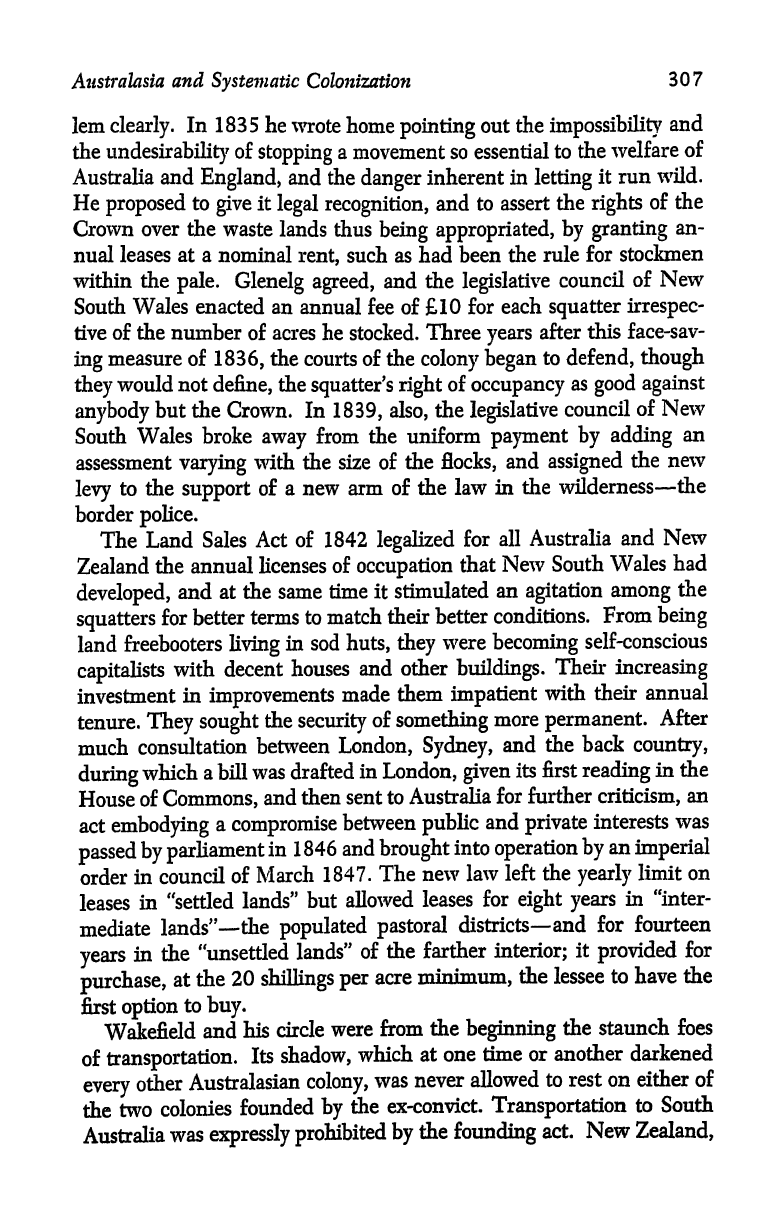
Aiistralasia
and
Systematic
Colonization
307
lem
clearly.
In
1835
he
wrote home
pointing
out
the
impossibility
and
the
undesirability
of
stopping
a movement so essential
to
the
welfare
of
Australia and
England,
and
the
danger
inherent
in
letting
it
run
wild.
He
proposed
to
give
it
legal
recognition,
and
to
assert
the
rights
of
the
Crown
over
the waste
lands
thus
being appropriated,
by
granting
an-
nual
leases at
a
nominal
rent,
such as had
been
the
rule
for
stockmen
within the
pale.
Glenelg
agreed,
and the
legislative
council
of
New
South
Wales enacted an
annual fee
of
10 for
each
squatter
irrespec-
tive of
the
number of acres he
stocked.
Three
years
after
this
face-sav-
ing
measure
of
1836,
the courts
of the
colony
began
to
defend,
though
they
would not
define,
the
squatter's right
of
occupancy
as
good
against
anybody
but the
Crown. In
1839,
also,
the
legislative
council
of New
South
Wales broke
away
from
the uniform
payment
by
adding
an
assessment
varying
with the
size
of
the
flocks,
and
assigned
the
new
levy
to
the
support
of
a new arm of
the
law
in
the wilderness
the
border
police.
The
Land
Sales
Act
of
1842
legalized
for
all
Australia
and
New
Zealand
the annual
licenses
of
occupation
that
New
South
Wales
had
developed,
and
at the same
time
it
stimulated
an
agitation
among
the
squatters
for better
terms
to
match their
better
conditions.
From
being
land
freebooters
living
in sod
huts,
they
were
becoming
self-conscious
capitalists
with decent
houses
and
other
buildings.
Their
increasing
investment
in
improvements
made them
impatient
with
their
annual
tenure.
They sought
the
security
of
something
more
permanent.
After
much
consultation
between
London,
Sydney,
and
the
back
country,
during
which
a
bill
was
drafted
in
London,
given
its
first
reading
in
the
House
of
Commons,
and
then sent
to Australia
for
further
criticism,
an
act
embodying
a
compromise
between
public
and
private
interests
was
passed
by parliament
in 1
846
and
brought
into
operation
by
an
imperial
order
in
council
of
March
1847.
The
new law
left
the
yearly
limit
on
leases
in
"settled
lands"
but
allowed
leases
for
eight
years
in
"inter-
mediate
lands"
die
populated
pastoral
districts
and
for
fourteen
years
in
the
"unsettled
lands"
of
the farther
interior;
it
provided
for
purchase,
at
the
20
shillings
per
acre
minimum,
the
lessee
to have
the
first
option
to
buy.
Wakefield
and
his
circle
were
from
the
beginning
the staunch foes
of
transportation.
Its
shadow,
which
at one
time or
another
darkened
every
other
Australasian
colony,
was
never
allowed
to rest
on either
of
the
two
colonies
founded
by
the
ex-convict.
Transportation
to South
Australia
was
expressly
prohibited
by
the
founding
act.
New
Zealand,
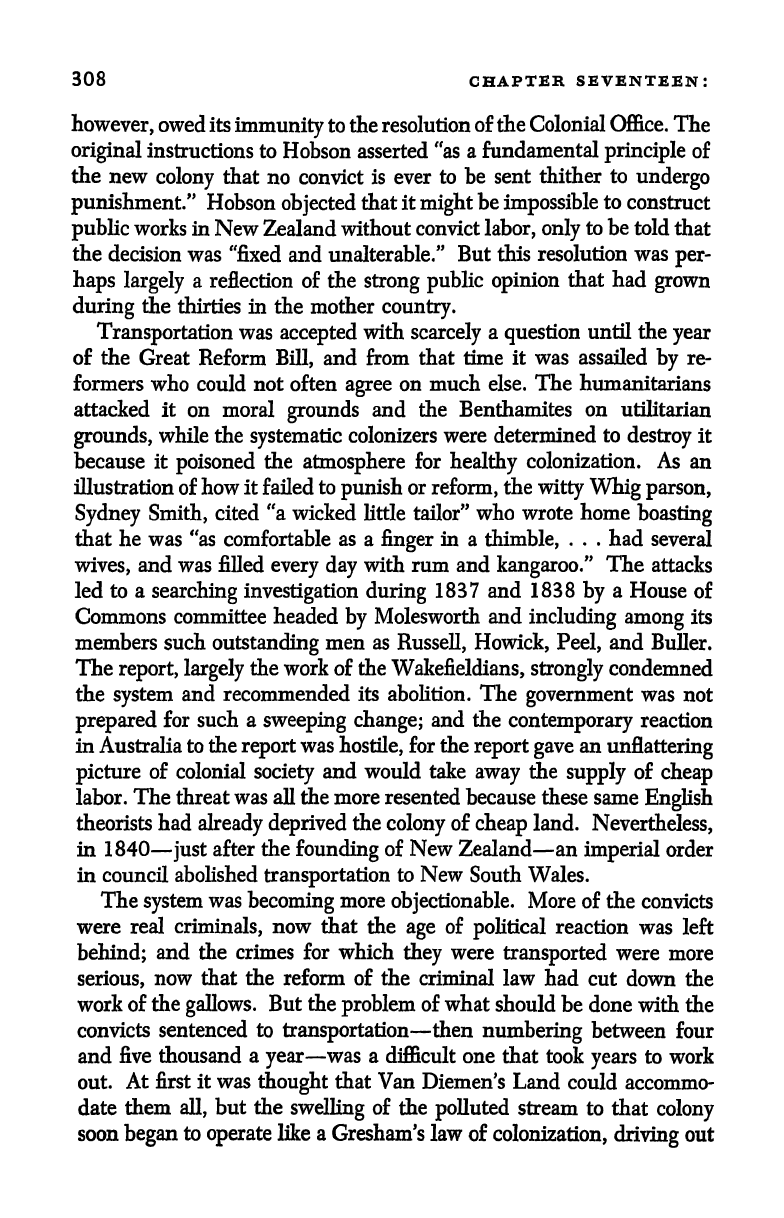
308
CHAPTER SEVENTEEN:
however,
owed its
immunity
to the
resolution
of
the
Colonial
Office.
The
original
instructions to
Hobson asserted
"as a
fundamental
principle
of
the new
colony
that
no
convict
is
ever
to he
sent
thither to
undergo
punishment."
Hobson
objected
that it
might
be
impossible
to
construct
public
works
in New
Zealand
without
convict
labor,
only
to
be
told
that
the
decision
was
"fixed and unalterable."
But this resolution
was
per-
haps
largely
a
reflection of the
strong
public opinion
that
had
grown
during
the
thirties in
the mother
country.
Transportation
was
accepted
with
scarcely
a
question
until the
year
of
the
Great
Reform
Bill,
and from
that time
it was
assailed
by
re-
formers
who could
not
often
agree
on
much
else.
The
humanitarians
attacked it
on moral
grounds
and
the Benthamites
on
utilitarian
grounds,
while
the
systematic
colonizers were determined
to
destroy
it
because it
poisoned
the
atmosphere
for
healthy
colonization.
As
an
illustration of how
it failed
to
punish
or
reform,
the
witty
Whig
parson,
Sydney
Smith,
cited
"a
wicked little tailor"
who
wrote home
boasting
that he
was
"as
comfortable
as
a
finger
in a
thimble,
.
.
.
had
several
wives,
and
was
filled
every
day
with rum and
kangaroo."
The
attacks
led to
a
searching
investigation during
1837
and 1838
by
a
House
of
Commons
committee headed
by
Molesworth and
including
among
its
members
such
outstanding
men
as
Russell,
Howick,
Peel,
and
Buller.
The
report,
largely
the work
of
the
Wakefieldians,
strongly
condemned
the
system
and recommended its abolition.
The
government
was
not
prepared
for such a
sweeping
change;
and the
contemporary
reaction
in Australia to
the
report
was
hostile,
for
the
report
gave
an
unflattering
picture
of colonial
society
and would take
away
the
supply
of
cheap
labor.
The threat
was
all
the more
resented because
these same
English
theorists
had
already
deprived
the
colony
of
cheap
land.
Nevertheless,
in
1840
just
after
the
founding
of
New
Zealand
an
imperial
order
in council
abolished
transportation
to New
South Wales.
The
system
was
becoming
more
objectionable.
More
of the
convicts
were
real
criminals,
now
that
the
age
of
political
reaction
was
left
behind;
and the
crimes for which
they
were
transported
were
more
serious,
now
that the reform
of the criminal
law
had cut
down the
work
of
the
gallows.
But the
problem
of
what
should be
done with the
convicts
sentenced to
transportation
then
numbering
between four
and
five thousand
a
year
was a
difficult one
that
took
years
to
work
out.
At
first it was
thought
that
Van Diemen's
Land
could
accommo-
date
them
all,
but
the
swelling
of
the
polluted
stream
to
that
colony
soon
began
to
operate
like a
Gresham's
law
of
colonization,
driving
out
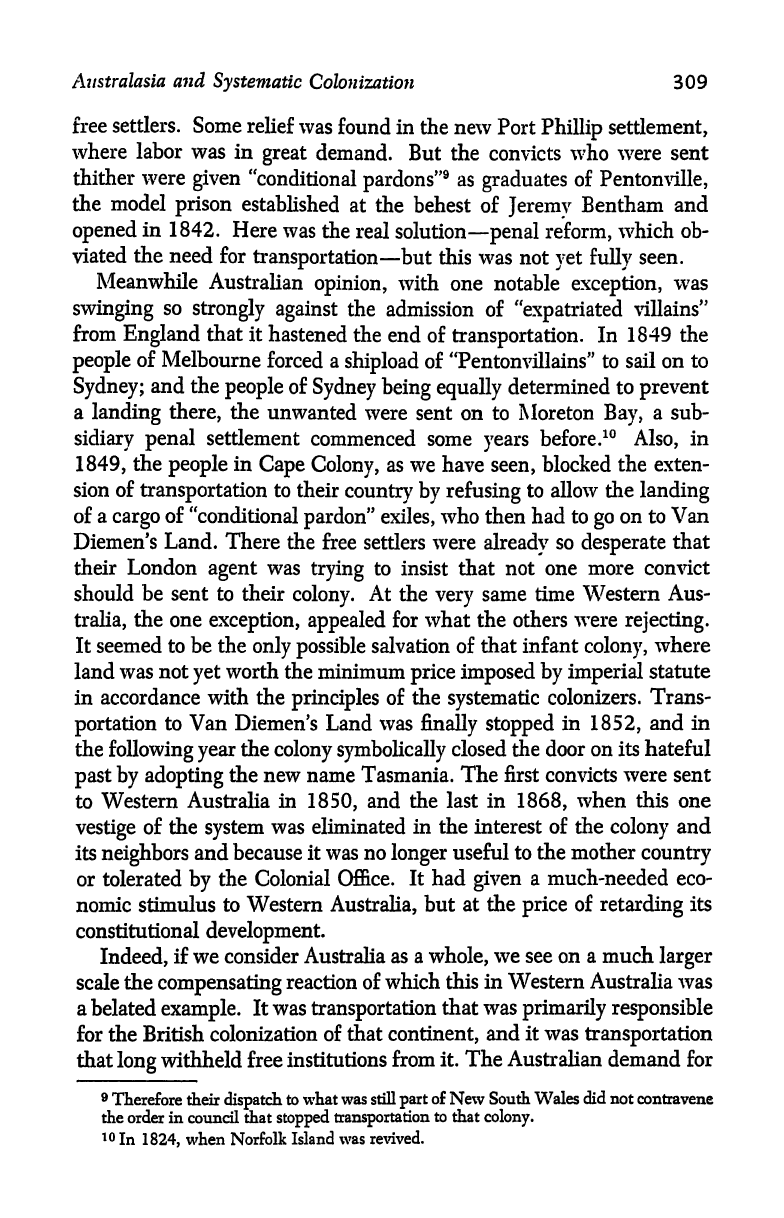
Australasia
and
Systematic
Colonization
309
free
settlers.
Some
relief
was
found
in
the new
Port
Phillip
settlement,
where
labor
was
in
great
demand.
But the
convicts
who
were sent
thither
were
given
"conditional
pardons"
9
as
graduates
of
Pentonville,
the
model
prison
established
at
the behest of
Jeremy
Bentham
and
opened
in
1842.
Here
was
the
real solution
penal
reform,
which ob-
viated
the
need for
transportation
but
this was not
yet
fully
seen.
Meanwhile
Australian
opinion,
with
one notable
exception,
was
swinging
so
strongly
against
the
admission
of
"expatriated
villains"
from
England
that
it
hastened the
end of
transportation.
In
1849
the
people
of
Melbourne
forced
a
shipload
of "Pentonvillains"
to sail on
to
Sydney;
and
the
people
of
Sydney
being
equally
determined to
prevent
a
landing
there,
the
unwanted were
sent on to Moreton
Bay,
a
sub-
sidiary penal
settlement
commenced some
years
before.
10
Also,
in
1849,
the
people
in
Cape
Colony,
as we have
seen,
blocked
the
exten-
sion
of
transportation
to their
country
by
refusing
to allow the
landing
of
a
cargo
of
"conditional
pardon"
exiles,
who then had to
go
on to
Van
Diemen's
Land. There
the
free settlers were
already
so
desperate
that
their
London
agent
was
trying
to
insist
that
not one more convict
should
be sent
to
their
colony.
At
the
very
same
time Western
Aus-
tralia,
the
one
exception, appealed
for
what the others were
rejecting.
It seemed to be the
only possible
salvation of
that infant
colony,
where
land
was
not
yet
worth the minimum
price imposed by imperial
statute
in accordance with
the
principles
of the
systematic
colonizers.
Trans-
portation
to
Van Diemen's
Land
was
finally stopped
in
1852,
and
in
the
following year
the
colony symbolically
closed
the
door
on its hateful
past by
adopting
the new name Tasmania.
The first convicts
were
sent
to Western
Australia
in
1850,
and
the last
in
1868,
when this one
vestige
of the
system
was eliminated
in the interest of
the
colony
and
its
neighbors
and
because it was no
longer
useful to
the mother
country
or tolerated
by
the Colonial Office.
It
had
given
a much-needed eco-
nomic stimulus
to Western
Australia,
but
at the
price
of
retarding
its
constitutional
development.
Indeed,
if
we consider
Australia
as a
whole,
we see
on
a
much
larger
scale
the
compensating
reaction of
which this
in
Western
Australia
was
a
belated
example.
It
was
transportation
that
was
primarily responsible
for the
British colonization
of
that
continent,
and
it
was
transportation
that
long
withheld
free
institutions
from
it. The Australian demand for
9
Therefore
their
dispatch
to
what
was
still
part
of
New
South Wales
did
not contravene
the
order
in
council
that
stopped
transportation
to that
colony.
10
In
1824,
when Norfolk
Island
was revived.
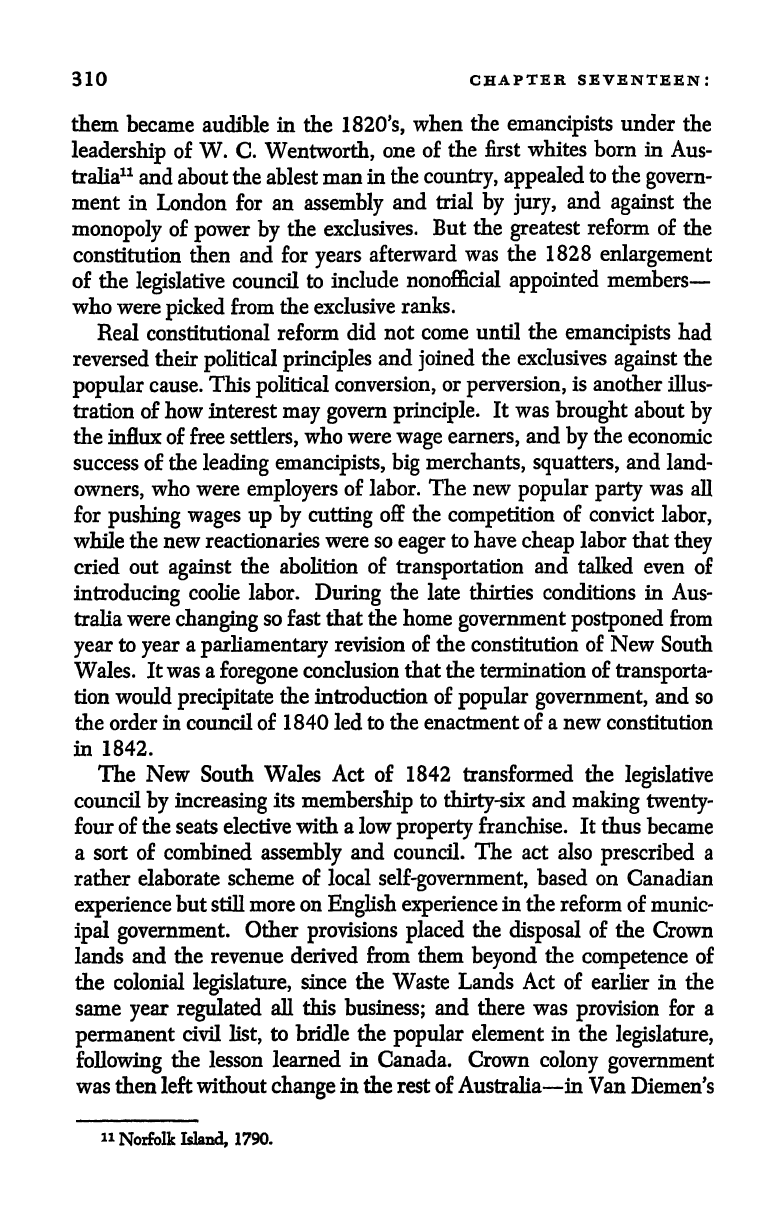
310
CHAPTER
SEVENTEEN:
them
became
audible
in
the
1820's,
when
the
emancipists
under
the
leadership
of
W.
C.
Wentworth,
one
of
the
first
whites
born in
Aus-
tralia
11
and about the
ablest
man
in
the
country, appealed
to
the
govern-
ment
in
London
for an
assembly
and
trial
by
jury,
and
against
the
monopoly
of
power
by
the
exclusives.
But the
greatest
reform
of
the
constitution
then and
for
years
afterward
was
the
1828
enlargement
of
the
legislative
council
to
include
nonofficial
appointed
members
who were
picked
from
the exclusive
ranks.
Real
constitutional
reform
did
not
come until
the
emancipists
had
reversed
their
political principles
and
joined
the
exclusives
against
the
popular
cause.
This
political
conversion,
or
perversion,
is
another
illus-
tration of
how interest
may govern
principle.
It was
brought
about
by
the
influx of
free
settlers,
who
were
wage
earners,
and
by
the
economic
success of
the
leading
emancipists, big
merchants,
squatters,
and
land-
owners,
who were
employers
of labor.
The new
popular party
was
all
for
pushing
wages up
by
cutting
off
the
competition
of
convict
labor,
while the
new reactionaries
were
so
eager
to
have
cheap
labor that
they
cried
out
against
the
abolition
of
transportation
and talked even
of
introducing
coolie labor.
During
the
late thirties
conditions
in
Aus-
tralia
were
changing
so fast
that
the
home
government postponed
from
year
to
year
a
parliamentary
revision
of the constitution of
New
South
Wales.
It
was a
foregone
conclusion that the termination
of
transporta-
tion
would
precipitate
the
introduction
of
popular government,
and so
the order in council of
1840
led
to
the
enactment
of
a
new constitution
in 1842.
The
New South
Wales
Act of
1842
transformed
the
legislative
council
by
increasing
its
membership
to
thirty-six
and
making twenty-
four
of the
seats
elective
with a
low
property
franchise.
It thus
became
a sort of combined
assembly
and council.
The
act
also
prescribed
a
rather
elaborate scheme
of
local
self-government,
based on
Canadian
experience
but
still more
on
English
experience
in the
reform
of munic-
ipal
government.
Other
provisions placed
the
disposal
of the
Crown
lands and
the
revenue
derived
from
them
beyond
the
competence
of
the
colonial
legislature,
since the Waste
Lands
Act
of
earlier in the
same
year
regulated
all
this
business;
and
there
was
provision
for
a
permanent
civil
list,
to bridle the
popular
element in
the
legislature,
following
the
lesson learned
in
Canada.
Crown
colony
government
was then
left
without
change
in
the rest of Australia in
Van
Diemen's
11
Norfolk
Island,
1790.
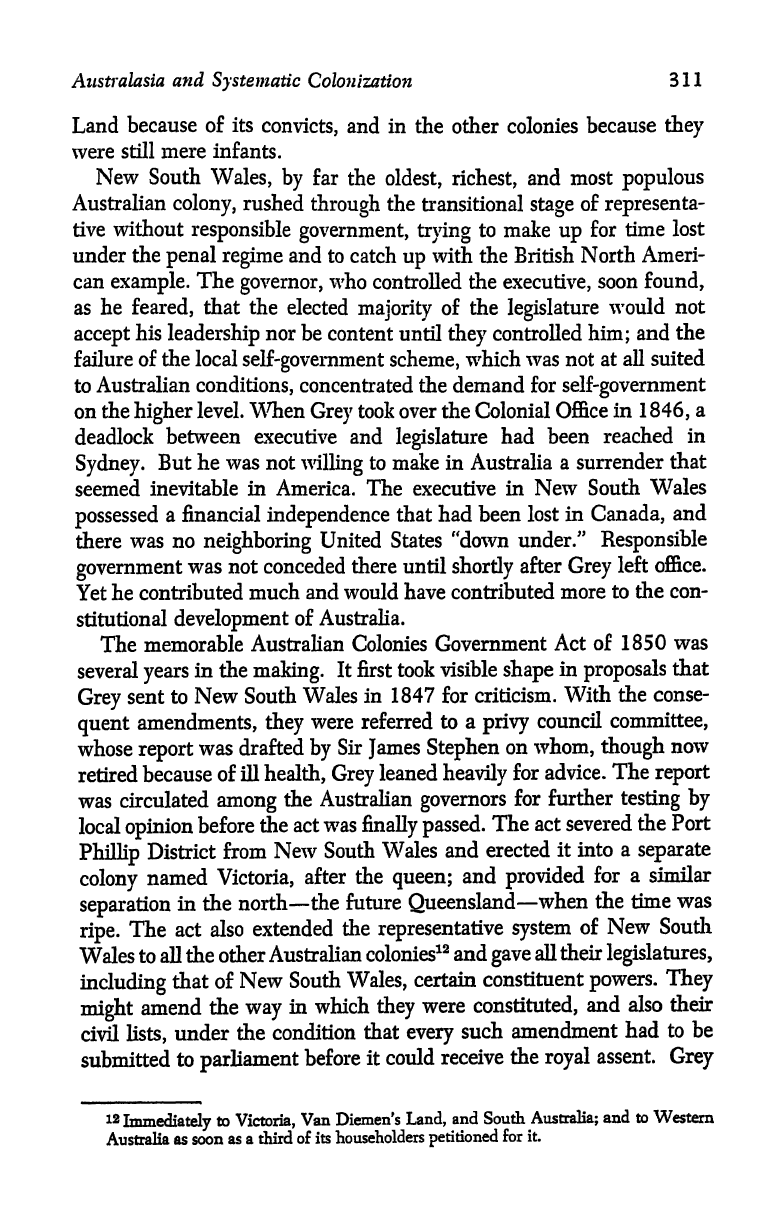
Australasia
and
Systematic
Colonization
311
Land
because
of
its
convicts,
and
in
the
other colonies
because
they
were
still mere
infants.
New
South
Wales,
by
far
the
oldest,
richest,
and
most
populous
Australian
colony,
rushed
through
the
transitional
stage
of
representa-
tive
without
responsible
government,
trying
to
make
up
for
time
lost
under
the
penal
regime
and to
catch
up
with
the British
North
Ameri-
can
example.
The
governor,
who
controlled
the
executive,
soon
found,
as
he
feared,
that
the
elected
majority
of
the
legislature
would
not
accept
his
leadership
nor
be content until
they
controlled
him;
and
the
failure
of the local
self-government
scheme,
which
was not
at
all suited
to
Australian
conditions,
concentrated
the demand for
self-government
on
the
higher
level. When
Grey
took over the Colonial Office
in
1
846,
a
deadlock
between executive
and
legislature
had been
reached
in
Sydney.
But
he
was
not
willing
to
make in Australia
a surrender
that
seemed
inevitable in America. The
executive
in New
South
Wales
possessed
a
financial
independence
that
had
been
lost
in
Canada,
and
there
was
no
neighboring
United
States "down
under."
Responsible
government
was not
conceded there
until
shortly
after
Grey
left
office.
Yet he
contributed
much and would
have contributed
more
to
the
con-
stitutional
development
of
Australia.
The
memorable
Australian Colonies
Government
Act
of 1850
was
several
years
in
the
making.
It
first
took
visible
shape
in
proposals
that
Grey
sent to
New
South
Wales
in 1847
for
criticism.
With
the conse-
quent
amendments,
they
were
referred
to
a
privy
council
committee,
whose
report
was drafted
by
Sir
James
Stephen
on
whom,
though
now
retired because
of ill
health,
Grey
leaned
heavily
for
advice.
The
report
was
circulated
among
the
Australian
governors
for
further
testing
by
local
opinion
before
the act
was
finally
passed.
The
act severed
the
Port
Phillip
District
from
New
South
Wales
and
erected
it into
a
separate
colony
named
Victoria,
after
the
queen;
and
provided
for
a
similar
separation
in the
north
the
future
Queensland
when
the
time
was
ripe.
The act
also
extended
the
representative
system
of
New South
Wales
to
all
the
other
Australian
colonies
12
and
gave
all
their
legislatures,
including
that of
New
South
Wales,
certain
constituent
powers.
They
might
amend
the
way
in
which
they
were
constituted,
and
also
their
civil
lists,
under
the
condition
that
every
such
amendment
had
to be
submitted
to
parliament
before it
could
receive
the
royal
assent.
Grey
12
Immediately
to
Victoria,
Van
Diemen's
Land,
and South
Australia;
and to
Western
Australia
as soon
as
a third
of its householders
petitioned
for
it.
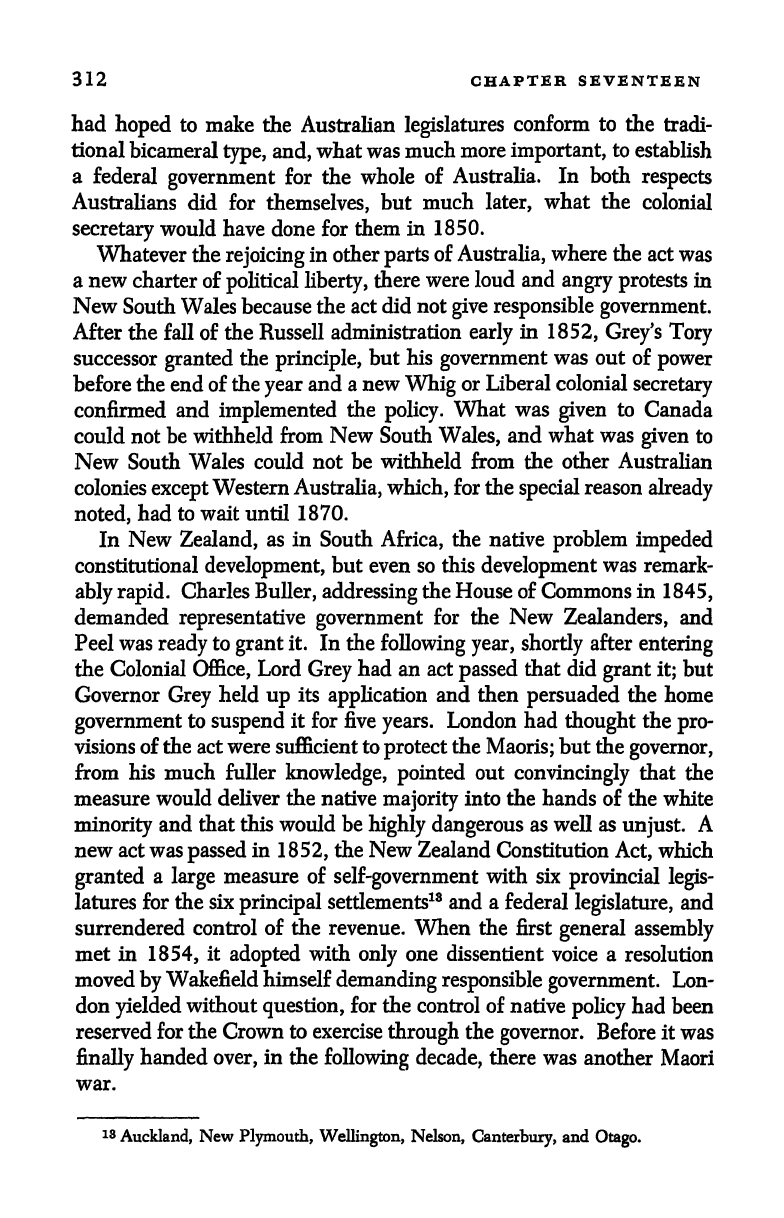
312
CHAPTER
SEVENTEEN
had
hoped
to
make
the Australian
legislatures
conform to
the
tradi-
tional
bicameral
type,
and,
what was much
more
important,
to
establish
a
federal
government
for the
whole
of
Australia.
In
both
respects
Australians
did
for
themselves,
but
much
later,
what the
colonial
secretary
would have done for
them
in
1850.
Whatever the
rejoicing
in
other
parts
of
Australia,
where
the
act
was
a new
charter of
political
liberty,
there
were loud
and
angry
protests
in
New
South Wales
because
the
act
did
not
give
responsible government.
After
the
fall
of
the
Russell administration
early
in
1852,
Grey's
Tory
successor
granted
the
principle,
but
his
government
was out
of
power
before
the
end of
the
year
and a new
Whig
or
Liberal
colonial
secretary
confirmed
and
implemented
the
policy.
What
was
given
to
Canada
could
not
be withheld
from
New South
Wales,
and
what
was
given
to
New
South Wales
could
not be withheld from
the
other
Australian
colonies
except
Western
Australia,
which,
for
the
special
reason
already
noted,
had
to wait
until
1870.
In
New
Zealand,
as in
South
Africa,
the native
problem
impeded
constitutional
development,
but
even
so
this
development
was
remark-
ably
rapid.
Charles
Buller,
addressing
the
House of Commons in
1845,
demanded
representative
government
for the New
Zealanders,
and
Peel
was
ready
to
grant
it.
In the
following year,
shortly
after
entering
the
Colonial
Office,
Lord
Grey
had
an
act
passed
that
did
grant
it;
but
Governor
Grey
held
up
its
application
and then
persuaded
the
home
government
to
suspend
it
for five
years.
London had
thought
the
pro-
visions of
the act were
sufficient to
protect
the
Maoris;
but the
governor,
from
his much
fuller
knowledge,
pointed
out
convincingly
that
the
measure
would
deliver
the
native
majority
into
the hands of the white
minority
and
that
this would be
highly
dangerous
as
well
as
unjust.
A
new
act
was
passed
in
1852,
the New
Zealand
Constitution
Act,
which
granted
a
large
measure
of
self-government
with
six
provincial
legis-
latures
for
the six
principal
settlements
13
and
a
federal
legislature,
and
surrendered
control
of
the revenue. When
the first
general assembly
met in
1854,
it
adopted
with
only
one dissentient
voice a
resolution
moved
by
Wakefield himself
demanding
responsible
government.
Lon-
don
yielded
without
question,
for the
control
of
native
policy
had
been
reserved
for the
Crown
to
exercise
through
the
governor.
Before
it
was
finally
handed
over,
in
the
following
decade,
there was
another
Maori
war.
13
Auckland,
New
Plymouth,
Wellington,
Nelson,
Canterbury,
and
Otago.
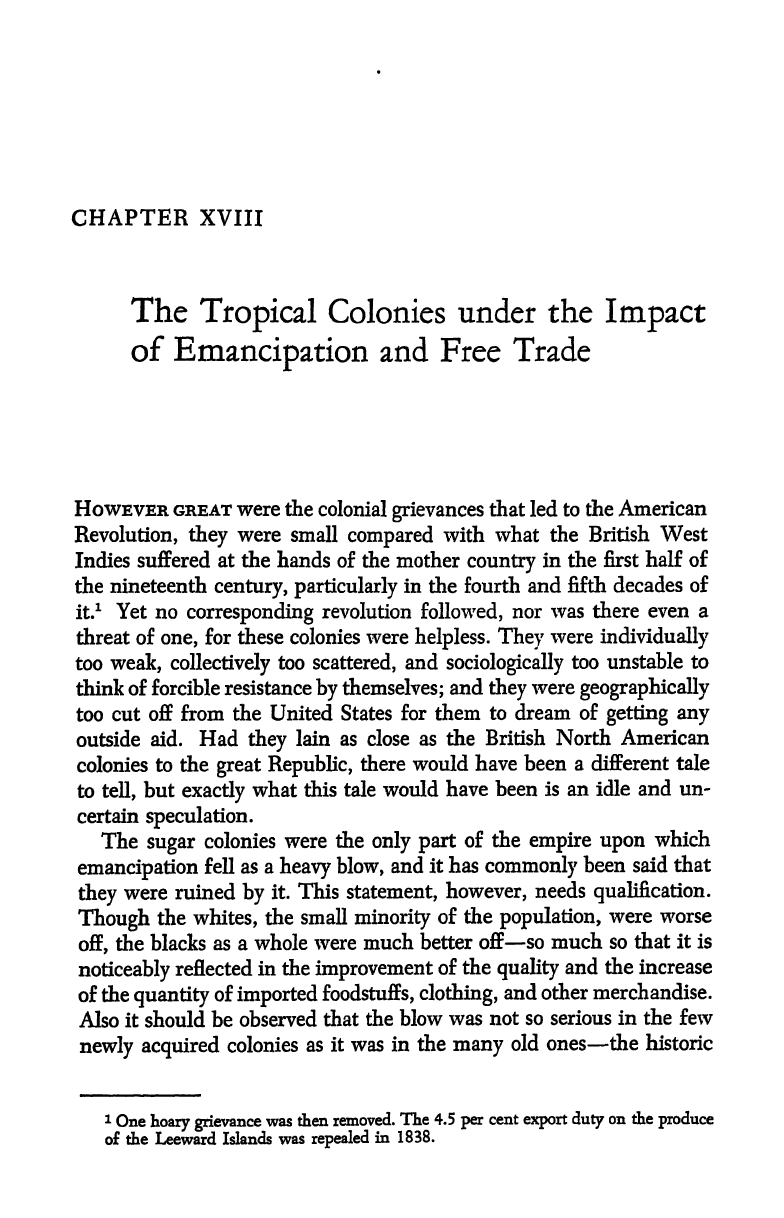
CHAPTER XVIII
The
Tropical
Colonies
under
the
Impact
of
Emancipation
and
Free
Trade
HOWEVER
GREAT were
the
colonial
grievances
that
led
to
the
American
Revolution,
they
were
small
compared
with what
the British
West
Indies
suffered
at
the hands of
the
mother
country
in the
first
half of
the
nineteenth
century, particularly
in
the
fourth
and fifth
decades
of
it.
1
Yet
no
corresponding
revolution
followed,
nor was
there
even a
threat of
one,
for
these colonies
were
helpless.
They
were
individually
too
weak,
collectively
too
scattered,
and
sociologically
too
unstable
to
think
of forcible
resistance
by
themselves;
and
they
were
geographically
too
cut
off from
the United
States
for
them
to dream
of
getting
any
outside
aid. Had
they
lain as
close as
the
British North
American
colonies
to the
great
Republic,
there would
have been
a
different
tale
to
tell,
but
exactly
what
this tale
would
have
been is
an idle
and un-
certain
speculation.
The
sugar
colonies
were
the
only part
of
the
empire
upon
which
emancipation
fell
as
a
heavy
blow,
and it
has
commonly
been said
that
they
were
ruined
by
it.
This
statement,
however,
needs
qualification.
Though
the
whites,
the
small
minority
of
the
population,
were
worse
off,
the
blacks
as
a
whole
were much
better
off so
much so
that
it
is
noticeably
reflected
in the
improvement
of
the
quality
and
the increase
of
the
quantity
of
imported
foodstuffs,
clothing,
and
other
merchandise.
Also
it
should
be
observed
that
the blow
was
not so serious
in the few
newly
acquired
colonies
as
it
was
in
the
many
old
ones
the historic
1
One
hoary grievance
was then
removed.
The
4.5
per
cent
export
duty
on
the
produce
of
the
Leeward
Islands was
repealed
in
1838.

314
CHAPTER
EIGHTEEN:
British
West
Indies.
There
it was
crushing
because
dry
rot
had
eaten
through
their
economic structure.
Absentee
proprietors,
long
the
rule,
had been
drawing
everything
they
could
out
of the
plantations
and
putting
nothing
back.
Without
knowing
it,
they
had been
living
on
capital.
For
the
management
of
their
estates
they
depended
upon
resident
agents,
called
attorneys,
whose
regular
remuneration
was 6
per
cent of the
gross
value
of
the
produce
that
they
shipped.
This was
a
heavy
burden even
when
the
attorney
was
both able
and
honest,
and
it was
augmented
in
various
ways
when,
as was
common,
he was
simultaneously
responsible
for
a
number
of estates. Then
there
were the
charges
of
the
London or
Bristol
merchant to whom the
sugar
was
consigned
for
sale,
through
whom
all
stores were
purchased,
and
by
whom the
whole business
of the
planta-
tion was
financed.
This man
usually
held a
strangling mortgage
on
the
property
and made
a
lot more out of it than
the
6
per
cent
interest
on
it.
He
collected
his
commission of 2.5
per
cent
on
the
gross
selling
price
of
the
sugar,
including
the
customs
duty,
for
which
he
advanced
the
money;
and
in the
beginning
of the 1830's the inclusion of
the
duty
in the
calculation
made
this
selling
cost
approximate
the
managerial
cost,
which the merchant remitted
to the
attorney.
In
addition,
the
merchant
charged
his
commission
on all the
supplies
he
bought,
and
made
a
still further
gain
by
paying
cash for the
goods
and
entering
the
credit
price
in
his
account with the
plantation.
More and more was
taken from less
and less.
The
fat
profit
once
guaranteed
by
the
monopoly
of
the
home market
had been
shrinking
away
under
die
competition
of
expanding
production
on
fresh
land
in
the
new
colonies
Trinidad,
British
Guiana,
and
Mauritius
and
under
the
pressure
of hard
times in the mother
country.
By
1831 the
price
of British colonial
sugar
in
bond
in
London had
fallen
to
23s.
8d.
a
hundredweight,
which
was 4d. less than the
specific
duty
it
still had
to
pay
and
was
not
a
third of what
the
price
had
been
in
1814.
Mean-
while
British
consumption
instead
of
increasing
with
the
cheapness
of
the article
had
actually
decreased
by
more than a
pound
to about 17
pounds
a head
yearly.
The
marvel is not
that
sugar
estates
changed
hands
with
great
frequency
and that
British
capital
was
disappearing
down
the West India
drain,
but that
a few
plantations
could show a
net
profit
until
1831,
when it
was
wiped
out
by
the
last
fall in
price.
From
this
low the
market
recovered,
and
the rise
continued
through
emancipation.
By
1836
the
price
was
up
to
40s.
10d.,
the
1819
level.
But costs
were
also
up
and
profits
down.
Indeed,
the
price
seems to
